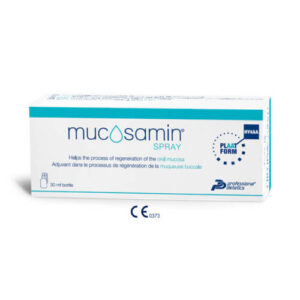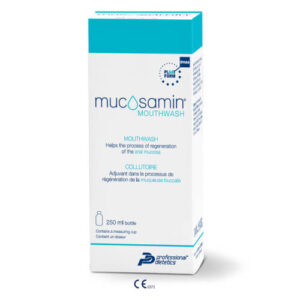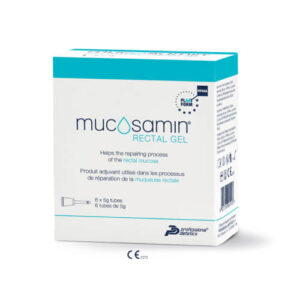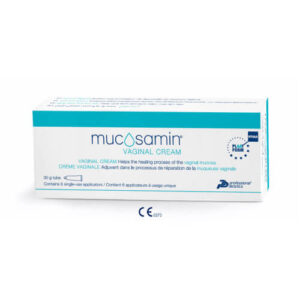Radiotherapy and Chemotherapy Induced Mucositis & Dermatitis
Mucosamin® & Radioderm® is a range of CE marked medical devices supporting the prevention and treatment of radiation and chemotherapy induced oral mucositis and radiation dermatitis, while also supporting the treatment of radiation and chemotherapy induced rectal and vaginal mucositis(1,4). Mucosamin & Radioderm contain sodium hyaluronate and the amino acids Glycine, L-Lysine, L-Proline and L-Leucine.
Role of Hyaluronic Acid
Sodium hyaluronate is the sodium salt of hyaluronic acid (HA), a key component of connective tissue (3,5), which has been shown to promote cell differentiation and cell motility(3,5). It is involved in assembly of extracellular matrix (ECM) proteins, where it serves as a scaffold for matrix proteins, exerts an anti-inflammatory effect(2), and promotes wound healing (5). HA increases in concentration during wound healing(6), and may facilitate collagen organisation and contraction during repair (2). It acts as an antioxidant for inflamed body tissues, protecting body tissue from free radical damage and supporting immune function by inhibiting microbes from moving between, and infiltrating cells(7). Hyaluronic acid in Mucosamin® & Radioderm® has been shown to promote cell proliferation, differentiation and motility(5). Mucosamin® & Radioderm®
Role of Amino Acids
Availability of amino acids, such as those present in Mucosamin® & Radioderm® support the role of HA in wound repair(5,6). The four amino acids present are involved in favouring wound healing by collagenogenesis and extracellular matrix (ECM) formation(5,6). Glycine constitutes 33% of the collagen molecule, whilst proline and lysine represent around 23% of collagen chains. Collagen deposition is essential in wound healing and is associated with normal ECM formation(6). It provides increased strength to the wound and facilitates macrophage and endothelial cell migration(6). The synthetic collagen precursor amino acids in Mucosamin are intended to promote the formation of collagen, and to improve and accelerate wound closure.
Mucosamin Spray
Medical Device Class IIa
30ml bottle
Directions of use:
- Begin the treatment with MUCOSAMIN Spray when the inflammation (reddening) first appears
- Apply a suitable amount of the product on the damaged mucosa. Repeat the treatment 3-4 times a day until the lesion heals
- Do not drink or eat and do not rinse your mouth for at least one hour after application
- Pay special attention to oral hygiene and avoid acidic and spicy foods
- In the presence of Candidiasis, the use of MUCOSAMIN spray can be combined with anti-fungal therapy
Mucosamin Mouthwash
Medical Device Class IIa
250ml bottle
Directions of use:
- Begin the treatment with MUCOSAMIN Mouthwash from first day of radiotherapy or chemotherapy
- Before treatment, remove any foreign material from the ulcerated area by rinsing or using a swab
- Rinse mouth 3-4 times per day using 5-10 ml of the product. Distribute the product evenly around the entire oral cavity and keep in mouth for at least 1 minute
- Do not drink or eat and do not rinse your mouth for at least one hour after application
Mucosamin Rectal Gel
Medical Device Class IIb
6 x 5g tubes
Directions of use:
- Begin the treatment with MUCOSAMIN Rectal gel from first day of radiotherapy or chemotherapy
- Before applying the product cleanse the affected area very well
- Remove the cap of the tube, introduce the applicator gently and press to dispense the entire gel content. If necessary, before introducing the applicator, take a small amount of gel and lubricate the applicator so it is easier to insert. Each tube is single-use.
- MUCOSAMIN Rectal gel should be applied once a day or more often, depending on the severity of symptoms
Mucosamin Vaginal Cream
Medical Device Class IIb
30g tube
Directions of use:
- Begin the treatment with MUCOSAMIN Vaginal cream from first day of radiotherapy or chemotherapy
- Before applying the product cleanse the affected area very well
- After removing the cap, screw on the applicator and squeeze the cream in the tube until the applicator is completely full
- Insert the applicator into the vagina and press the piston to dispense the cream. Applicators are single-use
- MUCOSAMIN Vaginal cream should be applied once a day or more often, depending on the severity of symptoms
Radioderm® Spray
Medical Device Class IIa
30ml bottle
RADIATION DERMATITIS
- Begin treatment with Radioderm as soon as the the skin shows signs of reddening.
- Before applying Radioderm to the irradiated skin cleanse the area very well.
- Spray Radioderm onto irradiated skin and smooth onto the affected area.
- Radioderm Spray should be used twice daily as recommended.
- Radioderm significantly reduces reddening, itching, burning and can prevent progression to ulceration.
References
- Mucosamin® Mouthwash , Oral Spray, Rectal Gel and Vaginal Cream, and Radioderm Spray® Instructions for Use. 2016.
- Mariggiò MA et al. Enhancement of fibroblast proliferation, collagen biosynthesis and production of growth factors as a result of combining sodium hyaluronate and amino acids. Int J Immunopathol Pharmacol 22: 485-492, 2009.
- Colella, G. et al. (2010) Efficacy of a spray compound containing a pool of collagen precursor synthetic aminoacids (L-proline, L-leucine, L-lysine and Glycine) combined with sodium hyaluronate to manage chemo/radiotherapy-induced oral mucositis: Preliminary data of an open clinical trial. International Journal of Immunopathology and Pharmacology, Vol. 23, pp. 143-151.
- Mucosamin DOF instructions for use MUCOSAMIN SPRAY. 1010461483 v 1.0 October 2018.
- Favia G, et al. Accelerated wound healing of oral soft tissues and angiogenic effect induced by a pool of aminoacids combined to sodium hyaluronate (AMINOGAM). J Biol Regul Homeost Agents 22: 109-116, 2008.
- Prosdocimi, M. (2012) Exogenous hyaluronic acid and wound healing: an updated vision. Panminerva Medica, Vol. 54, pp. 129-135
- Colella, G. et al. (2009) Aminoacid-enriched sodium hyaluronate enhances keratinocyte scattering, chemotaxis and wound healing through integrin B1 dependent mechanisms. The Journal of Stomatological Investigation, Vol. 3, pp. 21-29
- Cirillo, N. et al. (2014) A hyaluronic acid-based compound inhibits fibroblast senescence induced by oxidative stress in vitro and prevents oral mucositis in vivo. Journal of Cellular Physiology.
- Data on file. 1010461597 v 1.0 May 2019. Clinical data on the use of hyaluronic acid and amino acid microclysms in the prevention of chronic actinic proctitis in patients undergoing radiotherapy for prostate cancer.






